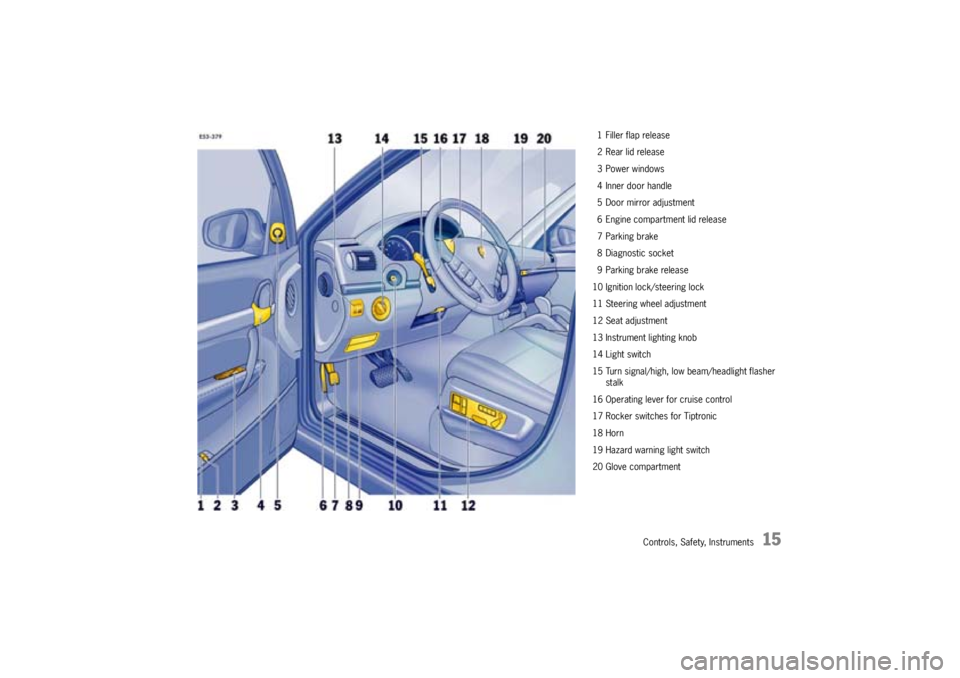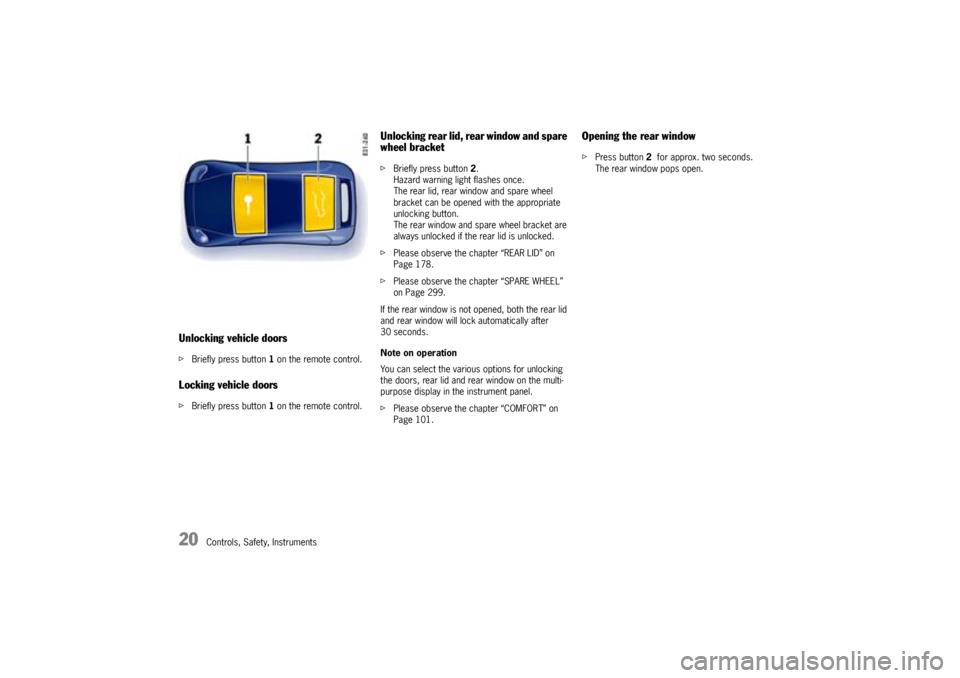light PORSCHE CAYNNE TURBO 2005 1.G Owners Manual
[x] Cancel search | Manufacturer: PORSCHE, Model Year: 2005, Model line: CAYENNE TURBO, Model: PORSCHE CAYENNE TURBO 2005 1.GPages: 369, PDF Size: 3.17 MB
Page 2 of 369

2Dear Owner,We would like to thank you for your purchase of a
Porsche Cayenne.
Judging by the car you have chosen, you are a mo-
torist of a special breed, and you are probably no
novice when it comes to automobiles.
Remember however, as with any vehicle, you
should take time to familiarize yourself with your
Porsche and its performance characteristics. Al-
ways drive within your own unique capabilities as
a driver and your level of experience with your
Porsche. Ensure that anyone else driving your
Porsche does the same. To prevent or minimize in-
jury, always use your safety belts. Never consume
alcohol or drugs before or during the operation of
your vehicle.
This Owner's Manual contains a host of useful in-
formation. Please take the time to read this manu-
al before you drive your new Porsche. Become fa-
miliar with the operation of your Porsche car for
maximum safety and operating pleasure. The bet-
ter you know your Porsche, the more pleasure you
will experience driving your new car.
Always keep your Owner's Manual in the car, and
give it to the new owner if you ever sell your
Porsche.A separate Maintenance Booklet explains how
you can keep your Porsche in top driving condition
by having it serviced regularly.
A separate Warranty and Customer Informa-
tion Booklet contains detailed information about
the warranties covering your Porsche.
For U.S. only:
If you believe that your vehicle has a fault which
could cause a crash, injury or death, you should
immediately inform the National Highway Traffic
Safety Administration (NHTSA) in addition to noti-
fying Porsche Cars North America, Inc. (Porsche
Cars N.A.).
If NHTSA receives similar complaints, it may open
an investigation, and if it finds that a safety prob-
lem exists in a group of vehicles, it may order a re-
call and remedy campaign. However, NHTSA can-
not become involved in individual problems be-
tween you and your dealer, or Porsche Cars N.A..
To contact NHTSA, you may either call the Auto
Safety Hotline toll-free at 1-(800)-424-9393
(or366-0123 in Washington, D.C. area) or write to:
NHTSA, U.S. Department of Transportation, Wash-
ington, D.C. 20590. You can also obtain other in-
formation about motor vehicle safety from the Hot-
line.Your car has thousands of parts and components
which have been designed and manufactured in
accordance with Porsche's high standards of en-
gineering quality and safety.
Any alteration of the vehicle may negate or
interfere with those safety features built into
the vehicle.
Your Porsche is intended to be used in a safe man-
ner obeying the local laws and in the light of driv-
ing conditions faced by you, and in accordance
with the instructions provided in this Owner's Man-
ual.
Do not misuse your Porsche by ignoring
those laws and driving conditions, or by
ignoring the instructions in this manual.
Any alteration or misuse of the vehicle can
lead to accidents and severe or fatal person-
al injuries.
Page 5 of 369

5
Environmentally friendly vehiclesModern environmental technology ensures compli-
ance with all emission laws applicable worldwide.
It has the following advantages:
– Rapid “operational readiness” of the catalytic
converters ensures low emissions, even in
short-trip operation.
– Reliable operation and good emission control
over a long useful life.
fPlease observe the chapter “FUEL ECONOMY”
on Page 249.
Recycling –
for a Porsche, this is virtually an
academic questionMore than two-thirds of all Porsches ever built are
still running.
But, just in case recycling is ever necessary,
we take the following precautionary
measures:
– Utilisation-friendly design.
– Identification of materials.
– Use of recyclable materials.
– Reusable components designed for simple
removal.
Emission control is built inInnovative engine technology combines high
engine performance and environmental compati-
bility.
The engine diagnosis system electronically
monitors the components and systems that affect
exhaust gases.
This continuous monitoring and fault storage
enables swift, reliable diagnosis and fault detec-
tion.
Faults are indicated to the driver by the “Emission
control” warning light and display.
fPlease observe the chapter “EMISSION CONT-
ROL” on Page 76.
Page 8 of 369

8Fuel QualityYour engine is designed to provide optimum performance and fuel economy using
unleaded premium fuel with an octane rating of 98 RON (93 CLC or AKI).
Porsche therefore recommends the use of these fuels in your vehicle.
Porsche also recognizes that these fuels may not always be available. Be assured that your vehicle will operate
properly on unleaded premium fuels with octane numbers of at least 95 RON (90 CLC or AKI),
since the engine's “Electronic Oktane™ knock control“ will adapt the ignition timing, if necessary.Fuels containing alcohol and etherSome areas of the U.S. require oxygenated fuels during certain portions of the year.
Oxygenated fuels are fuels which contain alcohols (such as methanol or ethanol) or ether (such as MTBE).
Under normal conditions, the amount of these compounds in the fuel will not affect driveability.
You may use oxygenated fuels in your Porsche, provided the octane requirements for your vehicle are met.
We recommend, however, to change to a different fuel or station if any of the following problems occur with your vehicle:
– Deterioration of driveability and performance.
– Substantially reduced fuel economy.
– Vapor lock and non-start problems, especially at high altitude or at high temperature.
– Engine malfunction or stalling.Fuels containing MMTSome North American fuels contain an octane enhancing additive called methylcyclopentadienyl manganese tricarbonyl (MMT).
If such fuels are used, your emission control system performance may be negatively affected.
The check engine warning lights on your instrument panel may turn on.
If this occurs, Porsche recommends you stop using fuels containing MMT.
Page 11 of 369

Controls, Safety, Instruments
11 Controls, Safety, Instruments
Porsche and the Environment .......................... 4
Never invite car theft! .................................... 16
Keys ............................................................ 17
Central Locking System ................................ 21
Porsche Entry & Drive ................................... 24
Doors .......................................................... 26
Alarm System, Ultrasound Passenger Compart-
ment Monitoring System, Inclination Sensor .... 27
Power Windows ............................................ 29
Front seats................................................... 32
Front seat with memory................................. 33
Easy Entry Function ...................................... 35
Headrests .................................................... 36
Rear Seats ................................................... 37
Heated Seats – Front and Rear ...................... 40
Safety Belts.................................................. 42
Child Restraint Anchorages ............................ 46
Child Restraint Systems ................................ 47
Airbag Systems ............................................ 49
Steering Wheel ............................................. 51
Multi-Functional Steering Wheel ...................... 53
Interior Mirror ............................................... 55
Door Mirrors................................................. 55
Automatic Anti-Dazzle Mirror .......................... 57
Ignition Lock/Steering Lock ........................... 58
Starting and Stopping the Engine ................... 60
Parking Brake ............................................... 62
Brakes ......................................................... 63
Instrument Panel USA Models ........................ 68
Instrument Panel Canada Models.................... 70
Oil Temperature Gauge ................................. 72
Speedometer ............................................... 72Cooling System ............................................ 73
Fuel ............................................................. 74
Odometer..................................................... 75
Emission Control........................................... 76
Multi-Purpose Display .................................... 78
Warning Lights and Warning Messages ......... 106
Light Switch ............................................... 114
Instrument Illumination ................................. 116
Automatic Headlight Beam Adjustment ......... 116
Turn signal/High Beam/
Headlight Flasher Stalk ................................ 117
Emergency warning lights............................ 118
Windshield Wiper/Washer Stalk .................... 119
Cruise Control ............................................ 122
Vents ......................................................... 125
Fresh-air intake ........................................... 125
Heated Rear Window ................................... 126
Automatically Controlled
Two-Zone Air Conditioning ........................... 127
Automatically Controlled
Four-Zone Air Conditioning ........................... 131
Parking Heater............................................ 137
Sun Visors .................................................. 142
Sun Blinds, Rear Side Windows .................... 143
Interior Lighting .......................................... 144
Door-Surrounding Lighting ........................... 146
Coming Home Function (Off Delay) ............... 146
Sliding/Lifting Roof ..................................... 147
Parking Aids ............................................... 157
Garage Door Opener ................................... 162
Ashtray ...................................................... 165
Cigarette Lighter......................................... 166Car Audio Operation/Tips ............................ 167
Porsche Communication
Management (PCM) ..................................... 170
Fire Extinguisher ......................................... 171
Storage...................................................... 172
Cupholder .................................................. 176
Rear Lid ..................................................... 178
Rear Window .............................................. 180
Engine Compartment Lid ............................. 180
Loadspace ................................................. 182
Luggage Compartment Cover ...................... 183
Luggage Safety Net ....................................185
Ski Bag ...................................................... 187
Roof Transport System................................ 189
Trailer Coupling .......................................... 190
Loading Information ....................................191
Page 12 of 369

12
Controls, Safety, Instruments
Dear Porsche OwnerA lot has gone into the manufacture of your
Porsche, including advanced engineering, rigid
quality control and demanding inspections. These
engineering and safety features will be enhanced
by you...the safe driver...– who knows his car and all controls,
– who maintains the vehicle properly,
– who uses driving skills wisely and always
drives within her/his own capabilities and the
level of familiarity with the vehicle.
You will find helpful hints in this manual on how to
perform most of the checks listed on the following
pages. If in doubt, have these checks performed
by your authorized Porsche dealer.
Before driving off...Check the following items firstfTurn the engine off before you attempt any
checks or repairs on the vehicle.
fBe sure the tires are inflated correctly.
Check tires for damage and tire wear.
fSee that wheel bolts are properly tightened
and not loose or missing.
fCheck engine oil level, add if necessary. Make
it a habit to have engine oil checked with every
fuel filling.
fCheck all fluid levels such as windshield wash-
er and brake fluid levels.
fBe sure the vehicle battery is well charged and
cranks the engine properly.
fCheck all doors and lids for proper operation
and latch them properly.
fCheck and if necessary replace worn or
cracked wiper blades.
fSee that all windows are clear and unobstruct-
ed.
fCheck air intake slots and area between en-
gine compartment lid and windshield are free
of snow and ice, so the heater and the wind-
shield wipers work properly.fIf a child will be riding in the vehicle, check
child seat/child seat restraint system to ensure
that restraints are properly adjusted.
fCheck all exterior and interior lights for opera-
tion and that the lenses are clean.
fCheck the headlights for proper aim, and if
necessary, have them adjusted.
fCheck under the vehicle for leaks.
fBe sure all luggage is stowed securely.
Emergency equipmentIt is good practice to carry emergency equipment
in your vehicle.
Some of the items you should have are: window
scraper, snow brush, container or bag of sand or
salt, emergency light, small shovel, first-aid kit,
etc.
Page 13 of 369

Controls, Safety, Instruments
13
In the driver's seat...fCheck operation of the horn.
fPosition seat for easy reach of foot pedals and
controls.To reduce the possibility of injury from
the airbag deployment, you should always sit
back as far from the steering wheel as is prac-
tical, while still maintaining full vehicle control.
fAdjust the inside and outside rear view mirrors.
fBuckle your safety belts.
fCheck operation of the foot and parking brake.
fCheck all warning and indicator lights with igni-
tion on and engine not running.
fStart engine and check all warning displays for
warning symbols.
fNever leave an idling car unattended.
fLock doors from inside, especially with chil-
dren in the car to prevent inadvertent opening
of doors from inside or outside. Drive with
doors locked.
On the road...fNever drive after you have consumed alcohol
or drugs.
fAlways have your safety belt fastened.
fAlways drive defensively.
Expect the unexpected.
fUse signals to indicate turns and lane changes.
fTurn on headlights at dusk or when the driving
conditions warrant it.
fAlways keep a safe distance from the vehicle in
front of you, depending on traffic, road and
weather conditions.
fReduce speed at night and during inclement
weather.
Driving in wet weather requires caution and re-
duced speeds, particularly on roads with
standing water, as the handling characteristics
of the vehicle may be impaired due to hydro-
planing of the tires.
fAlways observe speed limits and obey road
signs and traffic laws.
fWhen tired, get well off the road, stop and take
a rest. Turn the engine off. Do not sit in the ve-
hicle with engine idling.
Please observe the chapter “ENGINE EX-
HAUST” on Page 6.fWhen parked, always set the parking brake.
Move the Tiptronic selector lever to “P“.
On hills also turn the front wheels toward the
curb.
fWhen emergency repairs become necessary,
move the vehicle well off the road. Turn on the
emergency flasher and use other warning de-
vices to alert other motorists. Do not park or
operate the vehicle in areas where the hot ex-
haust system may come in contact with dry
grass, brush, fuel spill or other flammable ma-
terial.
fMake it a habit to have the engine oil checked
with every fuel filling.
Page 14 of 369

14
Controls, Safety, Instruments
Break in hints for the first
2,000 miles (3,000 kilometers)The following tips will be helpful in obtaining opti-
mum performance from your new Porsche.
Despite the most modern, high-precision manufac-
turing methods, it cannot be completely avoided
that the moving parts have to wear in with each
other. This wearing-in occurs mainly in the first
2,000 miles (3,000 km).Therefore:fPreferably take longer trips.
fAvoid frequent cold starts with short-distance
driving whenever possible.
fAvoid full throttle starts and abrupt stops.
fDo not exceed maximum engine speed of
4,200 rpm (revolutions per minute).
fDo not run a cold engine at high rpm either in
Neutral or in gear.
fDo not let the engine labor, especially when
driving uphill. Shift to the next lower gear in
time (use the most favorable rpm range).
fNever lug the engine in high gear at low
speeds. This rule applies at all times, not just
during the break-in period.fDo not participate in motor racing events,
sports driving schools, etc. during the first
2,000 miles/3,000 kilometers.
There may be a slight stiffness in the steering or
other controls during the break-in period which will
gradually disappear.
Break in brake padsNew brake pads and discs have to be “broken in“,
and therefore only attain optimal friction when the
car has covered several hundred miles or km.
The slightly reduced braking ability must be com-
pensated for by pressing the brake pedal harder.
This also applies whenever the brake pads and
brake discs are replaced.New tiresNew tires do not have maximum traction. They
tend to be slippery.
fBreak in new tires by driving at moderate
speeds during the first 60 to 120 miles/100
to 200 km. Longer braking distances must be
anticipated.
Engine oil consumptionDuring the break-in period oil consumption may be
higher than normal.
As always, the rate of oil consumption depends on
the quality and viscosity of oil, the speed at which
the engine is operated, the climate and road con-
ditions, as well as the amount of dilution and oxi-
dation of the lubricant.
fMake a habit of checking engine oil with every
fuel filling, add if necessary.
fPlease observe the chapter “ENGINE DATA” on
Page 346.
Page 15 of 369

Controls, Safety, Instruments
15
1 Filler flap release
2 Rear lid release
3 Power windows
4 Inner door handle
5 Door mirror adjustment
6 Engine compartment lid release
7 Parking brake
8 Diagnostic socket
9 Parking brake release
10 Ignition lock/steering lock
11 Steering wheel adjustment
12 Seat adjustment
13 Instrument lighting knob
14 Light switch
15 Turn signal/high, low beam/headlight flasher
stalk
16 Operating lever for cruise control
17 Rocker switches for Tiptronic
18 Horn
19 Hazard warning light switch
20 Glove compartment
Page 20 of 369

20
Controls, Safety, Instruments
Unlocking vehicle doorsfBriefly press button 1 on the remote control.Locking vehicle doorsfBriefly press button 1 on the remote control.
Unlocking rear lid, rear window and spare
wheel bracketfBriefly press button 2.
Hazard warning light flashes once.
The rear lid, rear window and spare wheel
bracket can be opened with the appropriate
unlocking button.
The rear window and spare wheel bracket are
always unlocked if the rear lid is unlocked.
fPlease observe the chapter “REAR LID” on
Page 178.
fPlease observe the chapter “SPARE WHEEL”
on Page 299.
If the rear window is not opened, both the rear lid
and rear window will lock automatically after
30 seconds.
Note on operation
You can select the various options for unlocking
the doors, rear lid and rear window on the multi-
purpose display in the instrument panel.
fPlease observe the chapter “COMFORT” on
Page 101.
Opening the rear windowfPress button 2 for approx. two seconds.
The rear window pops open.
Page 27 of 369

Controls, Safety, Instruments
27
A- Light-emitting diode for alarm systemAlarm System, Ultrasound
Passenger Compartment
Monitoring System, Inclination
SensorfPlease observe the chapter “ALARM” on
Page 101.
Avoiding false alarmsfAlways close the sliding/lifting roof and all door
windows.
fDo not leave a mobile phone switched on in the
glasses case of the roof console.
fAlways turn off the alarm system before you at-
tach a trailer. The inclination sensor could trig-
ger the alarm unintentionally.Switching onfLock the vehicle.
The alarm system, passenger compartment
monitoring system and inclination sensor are
switched on.
fPlease observe the chapter “CENTRAL LO-
CKING SYSTEM” on Page 21.Switching offfUnlock the vehicle.
The alarm system, passenger compartment
monitoring system and inclination sensor are
switched off automatically.
Note on operation
If you unlock the vehicle with the key at the door
lock, you must switch the ignition on (ignition lock
position1) within 15 seconds of opening the door
in order to prevent the alarm system from being
triggered.
Switching off the alarm system if it is
triggeredfUnlock vehicle doors or
fSwitch ignition on.Function indicationThe locking condition of the vehicle is indicated by
a rapid flashing of the light-emitting diode A on the
driver’s door.
The light-emitting diode goes out when the vehicle
is unlocked.
Passenger compartment monitoring system
and inclination sensor are switched on
fThe light-emitting diode flashes for 2 seconds,
rapidly, then slowly.
Passenger compartment monitoring system
and inclination sensor are switched off
fThe light-emitting diode flashes rapidly for
2 seconds, goes out for 28 seconds and then
flashes slowly.
Fault indication
fThe light-emitting diode flashes rapidly for
2 seconds, shines for 28 seconds and then
flashes slowly.